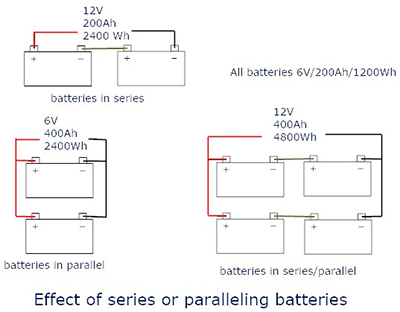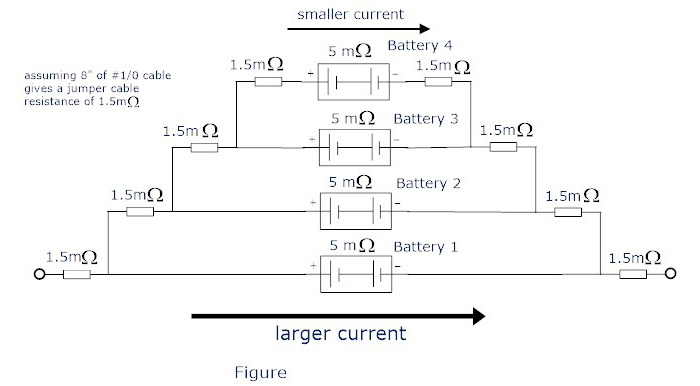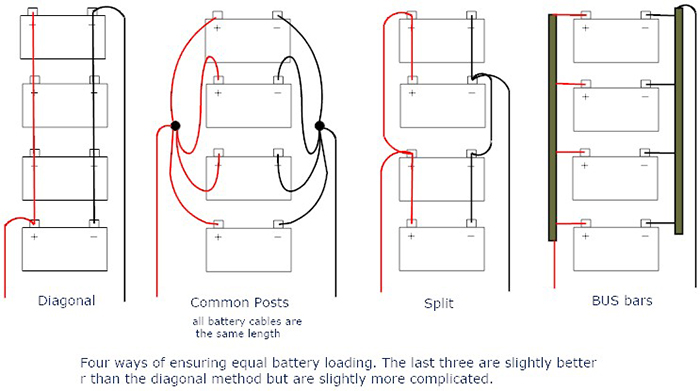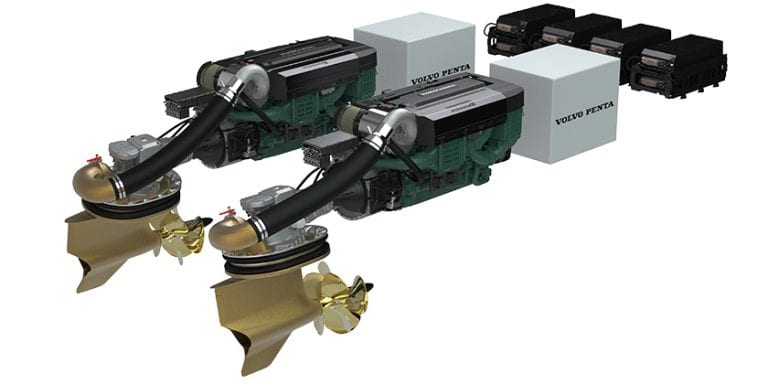Boat Nerd: DC Electrics – Part 6: Battery Banks – Connecting batteries in Series or Parallel

Mar 24, 2022
When it comes to building sizable house battery banks, you will probably need more than one battery. Combining multiple batteries in series and/or parallel will allow you to construct a larger battery banks.
Combining two batteries in series doubles the available voltage, the Amp-hour capacity of the bank is unchanged, but the Watt-hour rating of the bank doubles. Combining two batteries in parallel, the output voltage remains the same, the Amp-hour rating doubles, and the Watt-hour rating doubles.
We could also put two strings of two batteries in series and then put those strings in parallel (total of 4 batteries) which would double the voltage, double the Amp-hour rating, and quadruple the Watt-hour rating. See figure 11 for examples using 6V batteries such as Trojan Golf cart batteries to form a 12V house bank.
The same logic applies to paralleling 12V batteries to get a larger capacity 12V bank or construct 24 or 48V banks.
Figure 11
Internally within a lithium battery a similar thing is happening. Single or multiple cells (depending on individual cell capacity) are put in parallel and then 4 of these 3.2V cell/cell banks are put in series to create a 12V battery. With the lithium battery, a Battery management System (BMS) is normally also included to ensure none of the individual series connected cell/cell banks gets over or under charged during the operation of the battery.

How to connect your Batteries in Parallel
If you have two or more batteries connected in parallel, how should you make the vessel connections to the battery bank to ensure all batteries in the bank are worked equally hard? If you just jumper the batteries together and take the 12V plus and minus connections from the same batter (see Figure 12) the first battery in the sequence will be charged and discharged hardest while the battery furthest away will be lightly used.
Figure 13 shows why this is due to Kirchoffs current laws and the cascading jumper cable resistances.
 Figure 13
Figure 13
Figure 14 shows four ways of connecting to a string of 4 batteries to ensure the load is equally shared between all four. If you only have two batteries picking diagonal corners to attach the plus and minus cables to is the easiest.
 Figure 14
Figure 14
When fabricating bus bars from copper (tinned copper hopefully!) ensure you have sufficient ampacity by looking at the cross-sectional area. For a rectangular cross section multiply the height by the width. If the copper has a cross section of 5mm x 10mm you have 50 mm2 or the equivalent to #1/0 cable, which should be good for at least 150A.
Battery Monitor/Gauge
If you spend much time on your boat, especially away from the dock and shore power, a question that will arise is “how much energy do I still have left in my battery bank?” Various loads draw power from your house bank over a 24-hour period. Fridges draw power day and night, you use entertainment devices throughout the day, cabin lighting at night, navigation equipment while voyaging. How do you keep track of your power consumption? Perhaps you have some solar panels allowing for charging during sunlight hours or run your engine/alternator to recharge the batteries but how do you know how much energy you’re getting and when to start and stop engine-based charging?
What you need is a tank monitor or gauge for your battery. Luckily several companies make suitable products. Most employ a technique called coloumb counting. A shunt is placed in the wiring coming from your battery bank of interest (normally the negative lead) and the monitor looks at amps going out of the battery and amps going in. In addition to the instantaneous current flow, the monitor will also typically tell you the battery voltage, the net amount of how many Amp-hours (or watt-hours) have been consumed or charged (this may appear as a State-of-Charge %), and an estimate how long the current load could be maintained.
As many factors (chemistry, peukert factor/how high the discharge current is, battery efficiency, temperature, age) contribute to determining what the real capacity left is, the battery monitor is doing a best guess. Over time it will drift and become less accurate. Periodic full charges will allow the battery monitor to reset itself (and are good for Lead Acid batteries to prevent sulfation.) Lithium batteries are more of a challenge as they have such a flat charge/discharge curve voltage is not a good indicator of charge left (until it tanks) and there is no requirement or benefit to be fully charged daily. That said an occasional full charge will help keep the monitor somewhat synchronized.
Yearly capacity testing is a good idea. To do this, discharge the battery bank at a known rate and time how long it takes to reach a cutoff voltage. the chosen current multiplied by the discharge time will give you the current battery capacity. This capacity will shrink over time as the battery ages and putting this current value into your monitor in place of the original rated capacity will help keep your monitor accurate as well. For more details see an article at Marine how to (marinehowto.com) on the topic of keeping battery monitors accurate.
Manufacturers of battery monitors that may be of interest include, but not limited to, Xantrex, Victron with their 700 series devices and Balmar with their Smartgauge. The original Smartgauge was unique in that it determined/learned battery capacity over several cycles based solely on voltage, no current sensing needed. This worked well for Lead Acid chemistries but not so well for Lithium with it’s flat voltage curve. Balmar has recently released a new version of the Smartgauge, utilizing a current sensor, that works with all chemistries. Rod Collins, the owner of Marine How To website, was involved in the testing of this monitor and has written an article on the website if you would like more information.
Next issue: in the Last installment in our DC Electrics series, I will take a brief look at Inverters and MultiMeters.
 CYOB’s Boat Nerd, Mike Wheatstone, has enjoyed sailing since he was in his mid teens. A Queen’s electrical engineer by training, he spent his career working for Ontario Hydro and Hydro One. There he worked in engineering supporting the power system control centres.
CYOB’s Boat Nerd, Mike Wheatstone, has enjoyed sailing since he was in his mid teens. A Queen’s electrical engineer by training, he spent his career working for Ontario Hydro and Hydro One. There he worked in engineering supporting the power system control centres.
His first boat in 1980 was a Shark. With a growing family’s 2-foot-itis, there were upgrades to a Grampian 26, CS34 and currently a Hunter36. Now retired, Mike and his family spend summers on the Hunter (Dragonfyre) and winters in the Caribbean on their Leopard 43 cat (Peregrine).





























